Signage
Someone has outdone me on the building site sign front: http://www.chortleberry.com/l/photo_96710/Building_Site_Shenanigans
following the construction of london's new generation of skyscrapers
Someone has outdone me on the building site sign front: http://www.chortleberry.com/l/photo_96710/Building_Site_Shenanigans
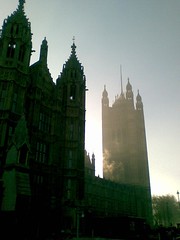 Nothing much to say, other than that one side effect of falling off my bike on Saturday is that I'm getting the tube to work. Which means I have been walking from Westminster tube... through the fog.. and past Westminster Abbey and the Houses of Parliament.
Nothing much to say, other than that one side effect of falling off my bike on Saturday is that I'm getting the tube to work. Which means I have been walking from Westminster tube... through the fog.. and past Westminster Abbey and the Houses of Parliament.
Spooky!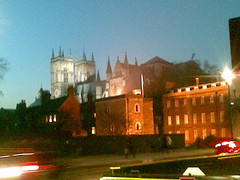
And below is another foggy photo, of Millbank Tower, but taken by Jane, not I. And looking, as is the wont of London artifacts these days, like something from the Mysterious Cities of Gold.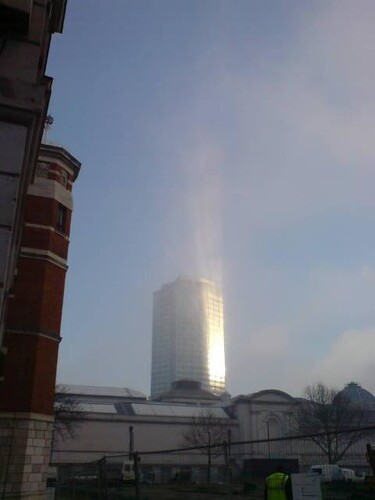
Music to watch fog by, by fog
Categories: West London
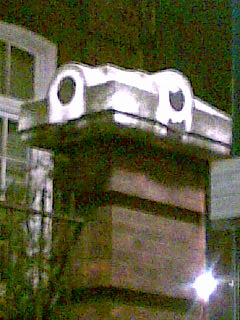 Looks a bit like the big golden bird in Mysterious Cities of Gold, does it not?
Looks a bit like the big golden bird in Mysterious Cities of Gold, does it not?
And it is to be found on Cornhill. Or possibly Cheapside. One or the other.
While I'm putting up photos of small things in the city, here also is a shop on Threadneedle Street. There's something very anachronistic about such a quaint little olde English tobacconists using fluorescent pieces of card for its pricing labels. I didn't go and have a closer look, but I dread to think they may have been written in permanent marker rather than copperplate printed.
You will also notice that though the awning proclaims "J. Bedford and Co", the plaque beneath the window says "H. Botterill & Sons, estd 1841". A cunning ruse to tempt in passing footfall who, too close to be able to see the awning, purchase their Havana cigars unaware that the claims to have been established in 1841 are of dubious provenence.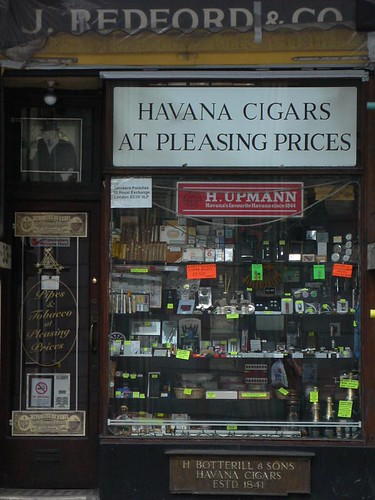
Categories: Beneath the skyline
 Isn't the weather just great at the moment! (Apologies for any insensitivity towards any readers from Bismarck, North Dakota). So great that I spent most of yesterday's daylight hours out of bed and out of doors, and intend on a repeat performance today, once the blog's finished.
Isn't the weather just great at the moment! (Apologies for any insensitivity towards any readers from Bismarck, North Dakota). So great that I spent most of yesterday's daylight hours out of bed and out of doors, and intend on a repeat performance today, once the blog's finished.
The morning involved seeing one of these, hearing one of these singing (always a good sign of spring) and nearly falling in the canal. In the afternoon I cycled along the canal to Limehouse with Tom for a couple of drinks on the waterfront, and where Beard also joined us later. Various sights along the canal: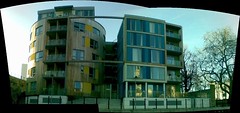
I like this building, but I don't think it fits in London at all. Modern looking, interestingly shaped and textured apartment buildings can work in London, but this clean, pine boarded and pastel panelled construction looks awkward in grimy Poplar. Charles keeps going on about traditional styles, and building modern structures in appropriate settings and, it turns out, I agree. I just think people focus too much on the size of buildings, and assume big ones are going to be eyesores.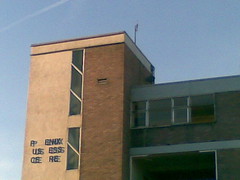
The Phoenix Business Centre, which is struggling - to say the least - to rise from its East London ashes.

Some interesting shadow effects on the water.
New flats going up in Bow/Stratford, near the olympic park.
Now - on to the main point if this post. There is much talk about preserving London's historic skyline. These energies would, I feel, be much better spent campaigning for the reinstatement of a public Thames waterfront.The Morpeth, near where I work, has numerous prints of old London scenes. One that caught my eye the other day was of Somerset House before Victoria embankment was built (similar to the picture to the right). It shows a public courtyard with steps leading down to the river.
As this article explains:
"London's roads were becoming increasingly congested and its sewers unable to cope ... The Embankment was intended to carry a new road along the edge of the Thames from Westminster to the City of London and, below ground, to accommodate large sewers and a line for the Metropolitan and District Railway.
The introduction of the Embankment had the effect of distancing the river from the buildings along its north bank, particularly significant for Somerset House, which had been designed to rise directly from the water ... The dramatic waterfront design of Sir William Chambers' Somerset House had effectively been destroyed a little more than a decade since the building of the New Wing had seen its completion."
 Somerset House is a particularly striking example of how there are very few places away from the South Bank where one can sit by the river. Limehouse is one of the very few. Unfortunately the view from there is blighted by the many cod-luxury low rise apartments opposite.
Somerset House is a particularly striking example of how there are very few places away from the South Bank where one can sit by the river. Limehouse is one of the very few. Unfortunately the view from there is blighted by the many cod-luxury low rise apartments opposite.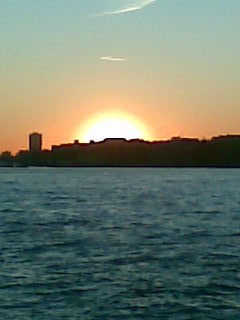
Categories: Architecture, London skyline
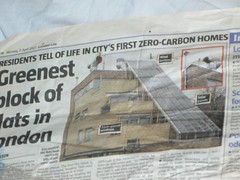 A number of disparate elements have come together to form this post.
A number of disparate elements have come together to form this post.
Categories: Architecture
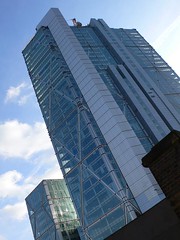 I'm not sure if I actually pointed it out the other day, but the Willis Building is still, as yet, unoccupied and is still evidently a bit of a mess inside. And yet, I have considered it finished for some time, and, looking at Broadgate Tower and considering it incomplete, I have come up with teh following criteria for a building's completion (for the purposes of this blog).
I'm not sure if I actually pointed it out the other day, but the Willis Building is still, as yet, unoccupied and is still evidently a bit of a mess inside. And yet, I have considered it finished for some time, and, looking at Broadgate Tower and considering it incomplete, I have come up with teh following criteria for a building's completion (for the purposes of this blog).
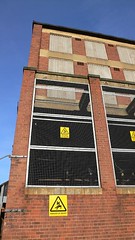 The photo on the right was taken from a street I've never been down before, also home to this fetching electricity substation. It provides a good view of the rear of the building which, to all intents and purposes, looks finished (although this doesn't hold true for street level).
The photo on the right was taken from a street I've never been down before, also home to this fetching electricity substation. It provides a good view of the rear of the building which, to all intents and purposes, looks finished (although this doesn't hold true for street level).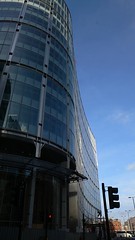 It also looks pretty polished from Bishopsgate Street, with the facade of 201 Bishopsgate snaking along the pavement, and now the glass reaches down to the ground (but not the cladding on the pillars, which remain resolutely gravity defiant).
It also looks pretty polished from Bishopsgate Street, with the facade of 201 Bishopsgate snaking along the pavement, and now the glass reaches down to the ground (but not the cladding on the pillars, which remain resolutely gravity defiant). He also makes expensive cakes and his little brother is following in his footsteps when it comes to the duty to stay out of politics.
He also makes expensive cakes and his little brother is following in his footsteps when it comes to the duty to stay out of politics.
But back to the matter in hand, Prince Charles delivered a speech last week attacking the policy of building tall buildings in London (like it hasn't all been said before).
"...will disfigure precious views and disinherit future generations of Londoners"I didn't know I was going to inherit a Londoner! But more seriously... err, it's just the same old argument - that we somehow are fortunate to live in a golden age of the London view. One so precious that it must be preserved despite the fact that London is a living city.
"...buildings that express nothing but outdated sustainability."What on earth does that mean???
"...retain the kind of human scale that attract so many people to them"As I wrote the other day, even moderately big buildings - necessary in places like the city - are always going to obscure buildings on a more human scale. Unless you favour parkland or bungalows you're on a hiding to nothing here.
"Parisian example of a high-rise urban quarter at La Defense effectively kept high-rise development away from central Paris."What he forgets though is that Paris' old buildings are far more intact than London's due to the blitz. So Paris doesn't have the same option to demolish hundreds of 1960's modernist blots that we do.
"...in Berlin, too ... the city leaders have insisted upon rigorous limitations to the height of new buildings. These kinds of approaches can help to achieve a far more coherent sense of harmony and civic self-confidence."Not sure what civic self-confidence is. Most of the top Google results are Prince Charles saying it in this speech and a previous one. The only other architectural use of it I can find is where civic self-confidence spawned town-planning, rather than the other way round (which seems a lot more feasible). If anyone knows what Charles means, and what mechanisms he thinks lead from smaller buildings to civic self-confidence, then let me know.
"My concern is that London will become just like everywhere else with the same homogenized buildings that express nothing but outdated unsustainability"... has he not been to the many cities around the world that have many tall buildings (including, it has to be said, London, as it has a few). Does he think all those cities are the same? If he does, then he clearly has no appreciation for the diverse, street-level, intimate feel he claims to know so much about.
"...how it can be considered sensible, or indeed rational, to implant such “congestors” [skyscrapers] into a network of streets which were designed to function with two to three storey buildings."
Categories: Architecture, London skyline
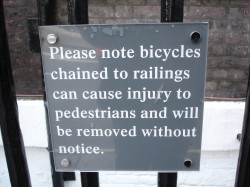 I've just had a narrow escape... I think. I parked my bike round the side of Liverpool Street station, away from the crowds. When I went to get my bike later there were some kids hanging about. A couple of them were starting to make their way towards me and gesturing for the others to come too, so I darted off as fast as I could.
I've just had a narrow escape... I think. I parked my bike round the side of Liverpool Street station, away from the crowds. When I went to get my bike later there were some kids hanging about. A couple of them were starting to make their way towards me and gesturing for the others to come too, so I darted off as fast as I could.
"You're an idiot," I hear you cry. "Why didn't you park your bike out front like someone who's not an idiot, you big fat idiot?"
And well might you ask.
Most of the railings around Liverpool Street have signs saying bikes will be removed on them (
Here is another illustrative story: http://www.london-se1.co.uk/forum/read/1/21843).
I pondered earlier in the day who had the authority to remove these bikes? The bike is on the street and, as I read the other day, even the police and other officials don't have the authority to remove bikes on the street, even if they're causing an obstruction (for the moment - it might be changing). And as the bike isn't actually on private property, merely leaning against it, one has to wonder if anyone has the authority to move it, even if there is a written warning there. If the written warning counted for anything then they could also put up signs giving them the right to move anything that passed by on the pavement... even people!
From the tfl website:
The question is, would the site security be breaking the law if they moved my bike? I think having a sign like that on the railings outside someone's house is fair enough, and I wouldn't dream of ignoring it. But outside a large office building in the City it seems inappropriate, and I would really like to flout the signs... but the risk is always that security will remove it and the police won't care enough to stop them or help me get it back. In fact, the police seem to condone it even though it would probably be acting illegally:Parliament Square and Whitehall security zone
There is one area in London where if you park at street level you won't find your bike where you left it - the security zone around Parliament Square and Whitehall. Here you need to take your bike to an underground car park and leave it there. If you don't it will be removed and taken to Charing Cross Police station.
Oh, and we won the rugby... or something.
- When parking on the street ... Avoid using "street furniture"as these may be removed by Local Authorities ... Ensure you are not ... using fixtures that have signs asking you not to secure your cycle to them (or it may be removed/double locked).

Please visit my new campsite listing site ukcampingmap.co.uk